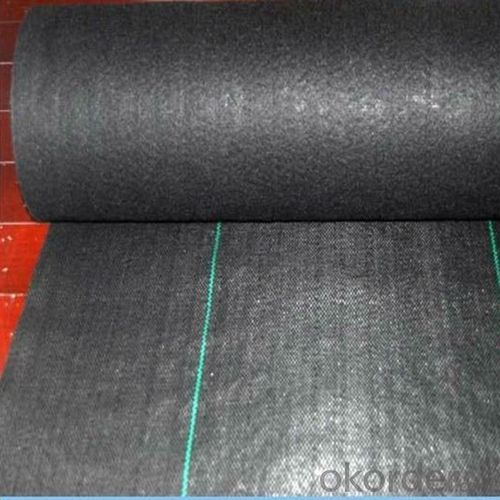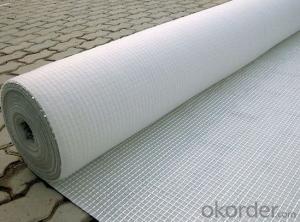16 Oz Non Woven Geotextile PP/PE Woven Fabric Weed Barrier Fabric Silt Fence
- Loading Port:
- Qingdao
- Payment Terms:
- TT or LC
- Min Order Qty:
- 5000 m²
- Supply Capability:
- 100000 m²/month
OKorder Service Pledge
OKorder Financial Service
You Might Also Like
1.Woven Fabric Description:
The woven fabric is a kind of vertical and horizontal weaving plastic woven cloth. It has good quality of permeability,water seepage and prevention and control of weeds. Widely used in gardening and agriculture.


2.Woven Fabric Functions and Features:
1)Excellent weed control
2)Excellent UV resistance
3)Moisture,fertilizers,air reach plants to allow for healthy soil
4)Good water and air permeability
5)Exceptional toughness and strength
6)Durable,tear-resistant,anti-rot and anti-mildew
7)Light weight,easy to install,follows natural ground contours
8)Ideal for use in landscaped beds,under decks and walkways

3. Woven Fabric Usage:
1.Prevent leakage disposal in landfill or waste water or waste dregs disposing field.
2.River bank ,lake dam ,mine remainings ,resevoir ,tunnel ,liquid storage pool(pit ,mine)
3.Preventing leakage in subway ,basement ,tunnel ,hole .
4.Anti-salt leakage in roadbed and other ground sill.
5.The plane direction laying of dam ,the vertical direction laying for ground sill.used in the construction fence and waste material field.
6.Used in ground sill of road ,highway ,railway and waterproof layer of welling clay and wet collapsed loess.
7.Preventing leakage on rooftop.

4. FAQ:
Q1: What is your minimum order quantity?
A:The minimum order quantity is 5000 ,but it is negotiable.
Q2:What is your payment terms?
A: T/T,Western Union,Paypal,L/C...
Q3:What is your delivery time?
A:Production time usually costs 2-20 days.
Waiting to cooperate with you!
- Q: The difference between the geotextile and the geotextile
- I professional production geotextile geomembrane and other geotechnical materials, a professional construction of the welding team, wish smooth
- Q: Can the nonwoven geotextile be used to hold the soil
- Yes, the soil is not lost on the line, ground watering, if the balcony need to consider good health problems. More vegetables on the issue of "pan rice race vegetables Q & A network
- Q: What is the filament single-sided singeing geotextile
- Filament single-sided singeing geotextile is through a series of hot-rolling process will filament geotextile side of the filament fiber roll hot filament geotextile surface of the unity, thereby increasing the filament geotextile non-slip, anti- Tear resistance. Filament singeing geotextile is generally used for landfill, tailings and other projects with rough surface geomembrane with the use of friction coefficient to increase and improve anti-skid performance. Filament single-sided singeing geotextile is the first production of finished filament geotextile, and then through the professional equipment for single-sided singeing.
- Q: Geotextile how to sampling
- Related methods can refer to GB-1998, can also go to our factory to purchase, to observe. My contact is the name of the registration. Free testing training! All the country's site can be shipped!
- Q: What are the factors that affect the effectiveness of geotextiles in erosion control?
- The factors that affect the effectiveness of geotextiles in erosion control include the type and quality of the geotextile material, the installation method and technique, the slope gradient and soil conditions, the presence of vegetation, and the level of maintenance and monitoring.
- Q: What are the advantages of using geotextiles in groundwater protection systems?
- Geotextiles offer several advantages in groundwater protection systems. Firstly, they act as a physical barrier, preventing the migration of pollutants and contaminants from seeping into the groundwater. This helps in safeguarding the quality and purity of the water source. Secondly, geotextiles provide filtration and separation capabilities, allowing water to pass through while retaining any suspended solids or particles. This enhances the overall efficiency of the groundwater protection system. Additionally, geotextiles are durable, resistant to degradation, and can withstand environmental stresses, ensuring long-term effectiveness in groundwater protection. Lastly, these materials are easy to install and maintain, reducing labor and maintenance costs associated with groundwater protection systems.
- Q: Geotextile special staple fiber where needed
- How much is a ton?
- Q: Can geotextiles be used in the protection of culverts?
- Yes, geotextiles can be used in the protection of culverts. Geotextiles are permeable fabrics that are commonly used in civil engineering projects to enhance drainage and soil stabilization. When used in culvert protection, geotextiles can prevent soil erosion and filter out fine particles, allowing for proper water flow while protecting the culvert from debris and damage.
- Q: What are the maintenance requirements for geotextile installations?
- The maintenance requirements for geotextile installations typically involve regular inspection to ensure the fabric is intact and functioning properly. Any signs of damage or deterioration should be repaired or replaced promptly. Additionally, geotextiles may require occasional cleaning to remove debris or sediment that can affect their performance. Overall, proper maintenance practices can help prolong the lifespan and effectiveness of geotextile installations.
- Q: Can geotextiles be used in groundwater protection systems?
- Yes, geotextiles can be used in groundwater protection systems. Geotextiles are permeable fabrics that can help in filtration and separation of different soil layers. They can be used to prevent the migration of fine particles and contaminants, providing an additional layer of protection for groundwater sources.
Send your message to us
16 Oz Non Woven Geotextile PP/PE Woven Fabric Weed Barrier Fabric Silt Fence
- Loading Port:
- Qingdao
- Payment Terms:
- TT or LC
- Min Order Qty:
- 5000 m²
- Supply Capability:
- 100000 m²/month
OKorder Service Pledge
OKorder Financial Service
Similar products
Hot products
Hot Searches
Related keywords




































